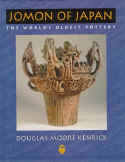
ORDER
Jomon
of Japan:
The World's
Oldest Pottery
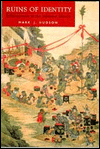
ORDER
Ruins
of Identity:
Ethnogenesis in the
Japanese Islands

ORDER
Folk
Art Potters of
Japan: Beyond an
Anthropology of
Aesthetics

ORDER
Of
Earth and Fire:
Tsui Collection of
Chinese Art in the
National Gallery of
Australia

ORDER
Dawn of the
Yellow Earth
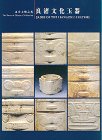
ORDER
Jades
of the
Liangzhu Culture

ORDER
Xi'an: China's Ancient
Capital, Third Edition
(Odyssey Guides)

ORDER
Radiant Stones:
Archaic Chinese
Jades
MORE ABOUT
 JADE JADE 
and
CHINA

ORDER
Craft
Production
and Social Change
in Northern China
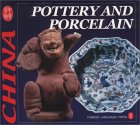
ORDER
Pottery and Porcelain (Culture of China)
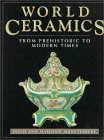
ORDER
World
Ceramics:
From Prehistoric to
Modern Times
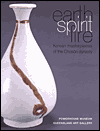
ORDER
Earth,
Spirit, Fire:
Korean Masterpieces
of the Choson
Dynasty (1392-1910)

ORDER
The
Ceramics of
Southeast Asia:
Their Dating and Identification

ORDER
A
Lasting Impression:
Coastal, Lithic, and
Ceramic Research in
New England
Archaeology

ORDER
First
Fish, First
People: Salmon Tales
of the North
Pacific Rim
Ainu, Ulchi, Nivkh, Salish, Makah, Spokane & more

ORDER
Anasazi
Pottery:
Ten Centuries of
Prehistoric Ceramic
Art in the Four
Corners Country of
the Southwestern
United States
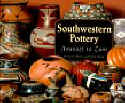
ORDER
Southwestern
Pottery: Anasazi
to Zuni
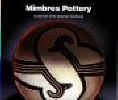
ORDER
Mimbres
Pottery:
Ancient Art of the
American Southwest
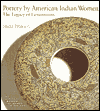
ORDER
Pottery
by
American Indian
Women: The Legacy
of Generations
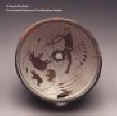
ORDER
To
Touch the Past:
The Painted Pottery
of the Mimbres
People: Essays

ORDER
Stylistic
Variation in
Prehistoric Ceramics:
Design Analysis in the
American Southwest

ORDER
The
Lapita Peoples:
Ancestors of the
Oceanic World
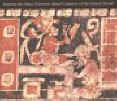
ORDER
Painting
the Maya Universe: Royal Ceramics of the Classic Period
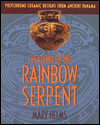
ORDER
Creations
of the
Rainbow Serpent:
Polychrome Ceramic
Designs from
Ancient Panama

ORDER
Pottery
and People: A Dynamic Interaction
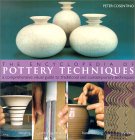
ORDER
The
Encyclopedia of
Pottery Techniques:
A Comprehensive
Visual Guide to
Traditional and
Contemporary
Techniques

ORDER
Xi'an: China's Ancient
Capital, Third Edition
(Odyssey Guides)
|
Japan | Asian Mainland | Bering Strait | N. America | Pacific | S. America
Pottery of
Ancient Japan [
Top ]
The world's
earliest pottery may be from Japan where, at Odai Yamamoto on northern Honshu, shards have been found
C14 dated to 13,000 BP, calibrated 16,000 years old, and confirmed by AMS or Accelerated Mass Spectrometer
dating. Pottery was also known then in China & the Russian Far East. Compare
ancient Jomon pottery [Japan] with Paleoeskimo pottery [Yukon, Canada] & Stallings
pottery [Georgia], below.
Early pottery was
found at the Kamino site in southwest Japan; shards were found with
microblades dated to ca. 16,000 years ago. Early pottery is also known from Fukui Cave on
Kyushu, C14 dated to 12,700 to 12,400 BP [calibrated ca. 16,000 years old]. Pottery at
Sempukuji Cave was dated ca. 13,000 years ago with thermoluminescent dating.
Jomon culture lasted 7,000+
years. The name means cord-marked or "cord pattern," precisely what
was found on their pottery. Jomon people made ceramic vessels plus animal figurines.
See many Jomon pots plus a
pointed bottom vessel from
earliest Jomon, similar to those from Siberia, plus incipient Jomon ovoid pots of Niigata plus and cord-marking.
Explore the pottery
of each phase of the Jomon culture:
· Incipient Jomon with plain and decorated pottery
· Earliest Jomon with cord-impressed pots with conical
bottoms as well
as shell-impressed and
carved-stick-impressed pottery
· Early Jomon with flat-bottomed pottery
· Middle Jomon with its elaborate pottery including flame style as well
as cord-marked pottery of the Middle Jomon
· Late Jomon with more ritual activity, more maritime
orientation and
pottery styles such as Horinouchi
· Final Jomon with simpler pottery styles including cord
marking
Early Jomon Earthenware Beaker: c. 5000 BP, from exhibit of Japanese art, "Quiet
Beauty," plus a Sue
Ware Ewer from the 6th century, more
View earliest
& middle Jomon pottery. See initial & early Jomon pots as well as middle Jomon
and late Jomon pots. See timeline.
From 5000 to 4000 BP, the
Jomon made elaborate
ceramics. This pottery of the Middle
Jomon includes
animal figures. Before and after that, ceramics were more utilitarian in design.
Some say that women potters made these ceramics; cord-marked pottery is
shown.
The purpose of pottery dogu figurines from the Jomon is unclear.
In 2000 AD, people
experimented with making Jomon pottery as well as the process of drying and then firing
Jomon pottery.
About 2300 years ago - or
perhaps as early as 3000
years ago - the Yayoi
people, originally from Northern China and Korea, entered the southern islands with a new
culture - and new, plainer ceramic style
as seen in this view of
Jomon
& Yayoi pottery and this of Yayoi
ceramics.
About 600 AD on the
northern island of Hokkaido, the traditional cord-marked Jomon pottery - including epi-Jomon
pottery - gave way
to the new Satsumon pottery style, apparently with the start of agriculture. Both the Satsumon & Okhotsk cultures developed their own
pottery styles and
they may have influenced each other. Both influenced the Ainu.
Periods of Japanese Cultures: differing sequences for Hokkaido for the
other islands - Jomon, Satsukon, Okhotsk, Yayoi, for reference
Pottery of the Ancient Asian Mainland [ Top ]
China:
Southern China's
earliest pottery dates to 16,000 BP, Zhang Chi
says. In the Russian Far East, the earliest pottery is C14 dated to 13,000 years ago
[calibrated to 16,000 years ago], Yaroslav
V. Kuzmin says. Pottery thus begins at comparable ages in China, Japan, the Russian
Far East.
Early
cord-marked pottery is also known from cave, shell-midden and open air sites in southern
China dated to 9,000 years ago as well as at the Spirit
Cave site in northeast Thailand.
Earliest village
has pottery: 8,200-year-old village in north China's Inner
Mongolia Autonomous Region, the Xinglonggou Site near the Xiliao River, has artifacts
including pottery, jade and shells, suggesting trading in the interior and to the coast, with a trade route to
northern Japan through northeast China and what is now the
Russian Far East.
Some of earliest
colored pottery in
China is from the Dadiwan culture,
c. 8,000 BP, among the earliest Neolithic evidence in Northwest China, while painted pottery was created in the Yellow River valley area
5000 years ago, including in Shaanxi province, home to Xi'an, plus pictures of China's Neolithic
pottery including Longshan, Banpo, others, and more Yangshao
& Lunghshan pottery and Yangshao pottery & Longshan jade
Banpo
Site - Yangshao Culture: 7000 years ago near Xi'an, people made pottery with coil or slab
technique and large village kilns, with more on Banpo and Yangshao culture known for painted
or red pottery and
more on Banpo ceramics with painted wares, a basin with "face"
made with circle and dot eyes, a pointed-bottom vessel reminiscent of early fabric-marked
pottery, another pointed-bottom
pot. Browse for more pots and fish
hooks similar to Japan, Amur River artifacts. Banpo Painted Pottery includes images of swimming fish, running deer,
barking dogs.
Chinese
Pottery & Bronze: by 6000 years ago, clay, bronze and jade were the primary materials
of Chinese art, while by 5000 years ago, the Chinese were making some of the earliest ceramics thrown on a wheel
Chinese Pottery Influences Bronze:
compare tripod pottery
pouring vessel and similar bronze vessel, and evolution of early Chinese ceramics
including a painted pottery urn from the Henan Langshao period some 5,000 years ago and a painted
pottery pan basin
from the Taosi Longshan culture 4,500 BP, and the jades of this period and the "taotie" face
Terra-cotta Warriors & Horses: and the
Emperor's Army,
extraordinary pottery from the burial of Qin, the first emperor, 200 BC, near X'ian
Russian Far
East, Amur River, Lake Baikal:
Pottery shards dated to
13,000 years ago, found in the Russian Far East's Amur River Valley. are among
Asia's oldest -- and show textile impressions on their exterior. On the Amur
River, ceramics are known in stage four of the Selemdjinskaya Culture starting ca.
12,000 years ago, and in the related Osipovskaya Culture at Gasya and Khummy sites.
Thermoluminescent
dating of pottery from Gasya, one of the Russian
Far East's earliest Neolithic sites, confirms radiocarbon dating of the pottery to before
10,000 years ago
Invention of pottery may have occurred independently in the Amur River basin ca. 13,000 BP, in
southern Japan ca. 12,000-12,700 BP and in southern China, ca.11,000-14,000 BP,
based on radiocarbon dates.
Pottery starts Neolithic in the Russian Far East with initial,
early and late stages. Gromatukha [pdf] complex on Middle Amur River corresponds to
initial stage ca. 13,300-10,400 BP, pottery with impressions of fabric, cordage or
cord-wrapped stick. Early Neolithic cultures are Rudnaya and Boisman in Primorye and
Yuzhno-Sakhalinsk on southern Sakhalin Island.
Pottery invention may have
occurred independently in the Lower Amur River and Transbaikal areas, before 10,000 years
ago. For example, the Osipovka and
Gromatukha sites have the earliest pottery from
the Russian Far East, C14 dated ca. 13,300-12,300 BP. They're Initial Neolithic,
contemporaneous with the earliest Neolithic in southern China and Japan.
Amur River pottery used untempered
or plant-tempered paste, simplicity of shape, undeveloped surface treatment and
low-temperature firing.
Ust-Karenga yielded the earliest pottery known from Siberia, dated to ca.
11,200-10,800 BP [Vitim River, Chita District, Transbaikal: see Chita east of Lake Baikal, west of Hokkaido; Vitim
River north of Chita]
By 9,000 years ago,
pottery was also known in the Lake Baikal region
not far from the headwaters of the Amur River. "Checkered
pottery" from
Yakutia's Lena River basin is linked to Chukotkan and Alaskan cultures.
Pottery was widespread in the Russian Far East by ca. 6700-8400 BP.
The Amur River, a 2,700-mile-long waterway, for thousands of years moved people and new
technologies including pottery and metal between the coast and forested interior. Ca. 5000
years ago on the Amur and Ussuri rivers, pottery
with mask-like faces matching rock art are found.
Korea:
Neolithic Korean Pottery showing an earthenware
vessel with
pointed bottom, comb-pattern, plus history of East Asian ceramics
Early Korean comb-patterned vessel [click Return on page for more] from the Amsa-Dong
site near the Han River, and a timeline of Korean history with pottery known from
9000 years ago
Pottery of Amsa-Dong: 6,000 year old site near Seoul yielded pointed-
bottom pots with geometric comb patterns and fish bone patterns, plus holes in the pit
house floors, apparently to hold the pottery. The pottery type is known as far north as
Lake Baikal in Siberia. More on Amsa Dong in pdf version with pictures of pottery,
dwellings, and another look at Neolithic Amsa Dong and its pottery, stone tools, pits houses
LEARN ABOUT
Chinese Imari, Japanese Imari, Canton and
other Oriental Pottery in an interview
with
Elizabeth Bradley of
Elizabeth Bradley Antiques [now closed] |
Pottery
of Ancient Bering Strait, Sea of Okhotsk [ Top ]
Siberia:
By 4,500 to 5,000 years ago, the people of the Bering Strait
in Siberia were using pottery with net impressions and later with cord impressions. They
carved ivory paddles
with patterns used to "consolidate" the clay and to impress patterns on the
exterior. This culture showed links those of the Yakutia region to the west in Siberia.
About 4,000 years ago, pottery making
spread from Siberia into Alaska.
Ancient Koryak ceramics have
been found on the north side of Talan Island located 150 km southwest of Magadan which is
on the north end of the Sea of Okhotsk. The pottery is dated to some 2,200 years ago.
Alaska:
About 4,000 years ago, pottery making
spread from Siberia to Alaska, or perhaps it arrived in Alaska ca. 3,500 years ago at the
start of the Norton tradition, including the Choris, Norton and Ipiutak phases. By 2,500 years
ago during the Norton culture phase, check-stamped
pottery and polished slate tools were used. The pottery with check-stamped design came
from Neolithic-era Siberia ca.
3000 BP, some say.
Fiber-tempered,
stamped pottery from Asia appears in Alaska with the start of the Norton Tradition 3000
BP, some say. At ca. 1000 BP, the Thule Eskimo have thick, gravel-tempered pottery.
In southwest Alaska, Arctic Small Tool
tradition people without pottery arrived about 3800 BP. About 2300 BP, Norton culture
people arrived. This culture group, with a maritime economy, used pottery and ground
slate. About 1000 BP, the Thule Eskimo culture, also with pottery, evolved north of the
Bering Strait in Alaska and spread east across the Canadian Arctic and south along the
coast of Alaska.
Pottery is one
example of cultural
transmissions that occurred between northeast Asia and northwest North America at
Bering Strait.
Pottery
of Ancient North America [ Top ]
Canadian Arctic &
Eastern Canada
Ancient pottery vessels
from different locations across Canada is linked to a map of their locations.
The Independence
I people, starting
about 4,000 years ago, had toggle harpoons but no evidence of pottery or stone blubber
lamps is found. They appear to have hunted musk ox, caribou, and seals.
The Pre-Dorset culture,
dated to 4,000 years ago, evolved, with change increasing around 3,000 years ago when the
culture is called Dorset. This latter people used soapstone for their vessels including
soapstone lamps, but not pottery. Ivory strips for sled runners are found along with dog
bones, clues the Dorset use dog sleds. Ivory carvings were made.
The Middle Paleo-Eskimo period
begins, including all Arctic Small Tool tradition complexes from 3,000 to 1,500 years ago.
Toggling harpoons are known, but people still used soapstone for vessels and lamps. Dorset
culture is a subset of these traditions. In the Late Paleo-Eskimo period again, harpoons and soapstone
vessels are used. Illustrations.
Again,
the Dorset people were
known for remarkable carvings of ivory and for toggle harpoons but not for use of pottery.
Illustrations.
The earliest pottery found in Canada was made some
3,500 years ago at a site in the northern Yukon near the Arctic Ocean. This Paleoeskimo
pottery is believed to be inspired by Siberian ceramics. Thus, while the Dorset peoples to
the east are not using pottery, the new technology is beginning to arrive. About 2,500 years ago, pottery making
arrived in southeastern Canada from the eastern United States.
This check-stamped pottery
is considered to be of the late Arctic Small Tool tradition people in western Canada. This
pottery [ another view
] found in the Yukon and dated to 3,500 years ago shows stylistic links to the Norton
pottery of Alaska. See Stallings pottery in Georgia and Jomon pottery from Odai Yamomoto
for interesting comparisons.
In
Quebec, pottery with harpoons and fishhooks is found in Meadowood and Point
Peninsula and Laurel culture sites, the latter type also found in the Upper Midwest USA. Dates
run 3000 to 1500 years
ago here.
About 2,700 years
ago, pottery production arrived in eastern Canada's Maritime region,
apparently from the northeast U.S. The Red Bank site in New Brunswick shows similarities to
the Adena Culture of Ohio. In the Ottawa
Valley, conoidal
pottery with dentate markings on the exterior.
By 2,300 years ago,
the Middle Dorset era people of Greenland and some northcentral
Canadian peoples were using pottery.
When the Thule Eskimo culture evolved in
northern Alaska and then spread east to Greenland, they were using pottery, not soapstone lamps.
The Northwest Coast Indians of Canada, including Haida and Tlingit,
used wood for their vessels but apparently never adopted pottery.
Some 500 years ago,
the Mackenzie Inuit
were making pottery of the conoidal shape known in Asia thousands of years before. Even
earlier, Saskatchewan's native people also made conoidal pottery.
Illustrations.
Southeastern
United States:
Pottery
from Stallings Island, a large shell-midden site in the Savannah River near Augusta,
Georgia, is thought to be the earliest prehistoric pottery in North America, dated to
circa 3800 to 4000 years ago.
Stallings pottery was part of
Woodlands culture in South Carolina some 4,000 years ago. Compare Jomon and Canadian Yukon
pottery, above.
Prehistoric ceramic
types of Northwest Florida, illustrated, including
check-stamped pottery from Late Archaic and Early Woodlands periods. The transition is
dated to ca. 4000 years
ago. Some say the first pottery east of the Mississippi River was from the Gulf
Coast, 4000 BP.
Mid-Atlantic
& Northeastern United States:
Adoption of
conoidal-shaped pottery
vessels to replace
soapstone vessels occurred ca. 3000 BP in Maryland. See Selden Island, Coulbourn, others
for illustrations of cord or net impressions on the exterior.
The transition from
soapstone to pottery vessels in southern New England occurred ca. 3200 and 3000
uncalibrated years BP. The pots were conoidal, with pointed not flat bottoms. The surface
of the pottery had a cord-marked pattern. These style features have parallels in east
Asian pottery starting thousands of years earlier. Includes sketches.
See
characteristics of ancient ceramic vessels including conoidal shape, ie.
cone-shaped base.
This early pottery is
part of the Windsor
tradition of prehistoric ceramics detailed in chronological order.
Midwestern United States:
Southern Minnesota's
native people made Fox
Lake pottery 2,200
years ago, including a cord-marked variety made with a cord-wrapped stick, while northern
Minnesota's native people made Laurel
pottery that included a dentate stamp decoration
Explore 30+
North American pottery types, from the Midwest and Southwest regions from Allamakee Ware to Weeden Island
Ware
Southwestern United States:
History of Native
American Pottery: emphasizing the West, Southwest
Some say coastal
California's native peoples did not use pottery, but near San Diego and in Baja
California they made pottery 2,500 years ago, using different styles and clays depending
on coastal or inland locations. One type is Kumeyaay Pottery,
made with paddle and anvil technique. Few native Californians besides the Kumeyaay and neighbors had pottery.
Foothill
Yokut Indians of
the western slopes of the Sierra Nevada mountains in the San Joaquin Valley of Central
California made rough, unglazed pottery using the coil method.
Southwest pottery is more
than 2000 years old, with Hohokam pottery found as early as 200 B.C. plus more on history of Southwest Pottery.
Gila Pottery - the earliest pottery in New Mexico's Gila
River area is Gila Plain of the Hohokam people, 150 A.D. Mogollon, Mibres and Salado
pottery followed. Anasazi ceramics influenced Southwest ceramic styles, as see in this
collection of Anaszi wares.
Some 1500 years ago,
pottery reached native people southern Idaho from the Fremont and
Anasazi of Utah which touches Arizona, New Mexico and
Colorado at the Four Corners. [Scroll down both pages]
Prehistoric pottery may have arrived in Central Texas ca.
800 years ago from the east and north, for use in
boiling or cooking food over a fire.
Making cordmarked
pottery by adding
coils of clay and working the shape with an anvil rock and a cord-wrapped paddle is
illustrated with many color photos. Native cordmarked pottery of Texas Panhandle is shown.
Pottery of
the Ancient Pacific Islands [ Top ]
About 3,500 years ago,
people likely from southeast Asia moved into an arc of Pacific islands stretching from New
Guinea to Fiji and Samoa, bringing their distinctive Lapita pottery with stamp impressions.
Study of ancient pottery
shards found in Tonga support the idea this Lapita ceramic tradition was imported from the west.
Pottery
of Ancient South & Central America [ Top ]
Candidates for South
America's oldest ceramics include:
· Fiber-tempered, elaborately decorated pottery created ca. 5900 B.P
at the San
Jacinto I site in Colombia
· Pottery made at Valdivia on
Ecuador's Santa Elena Peninsula, dating
to ca. 5000-4500 BP. Ceramics-making appeared there [map]
suddenly,
suggesting it came from Jomon-era Japan,
a controversial idea
[pdf]
with scholars pro
and con. Valdivia pottery
reveals ancient textiles.
· Or pottery made at Puerto Hormiga
on Colombia's north coast at
about the same time as the Valdivia ceramics
Some of Central America's
earliest pottery is from the Santa Rita site in
Belize, dated to 4,000 BP, while pottery is usually found at sites dated to 2500 BP such
as the Mayan site of Lamanai in
Belize.
In northwest Honduras, the
earliest pottery is from the pre-Olmec period, dated to 3600 BP with artifacts found at
the Puerto
Escondido site including small drinking vessels for sipping a chocolate drink
Pottery-making, a new
technology, arrived in
eastern Canada ca.
3,000 BP after diffusing north from southeast United States, where it perhaps had arrived
from South America via the larger Caribbean Islands, the
Greater Antilles. Likely sources were the Orinoco region and northern
Venezuela. However,
that
pottery is quite
different from Woodlands culture pottery.
By the Classic Maya Period,
ceramics were colorfully painted as seen in these
examples from Guatemala and Mexico. Other examples from South and Central America include:
· Maya ceramic
tripod bowl from El Salvador, about 550 AD
· Large ceramic storage vessel
from Peru, about 1200 AD
More about Pottery & Ceramics
Ancient Pottery Techniques: coil method, paddle and anvil method
Ancient
Pottery Vessel Types
including early conoidal pots
Ancient Pottery -
Pithos: early
Greek pottery included oval-shaped pithos contained meant to be half-buried in the ground,
amphora, other forms
Amphora,
an ovoid vessel originally pointed on the bottom and meant to be pressed into sand or soil
to hold it upright
East Asia's Pottery Centers were
China, Japan and Korea, with a look at pottery-making techniques including coils and
paddles, periods and styles
Ceramics
Resources from ArchNet - by continent
Dogs in Pottery
& Ceramics: A Sampling
Han
Dynasty Pottery Dogs - one seated, one standing, plus hores, human figures, from 200
B.C. China
Chinese Fu Dog - in colorful
ceramics, plus a pottery Colima dog vase from Mexico and more on dogs in mythology and
folklore
PreColumbian Colima Dog - canine
figure from Mexico in museum
Ceramic Colima Dog -
figure of plump dog from Mexico with ear of corn in its teeth, a museum replica
Staffordshire Pottery Dogs - breeds
such as spaniels, pugs, poodles, hounds, whippets, in famous English pottery
Victorian
Staffordshire Pottery Dogs - breeds such as spaniels, poodles, Dalmatians and more,
from the 1800s
.
|